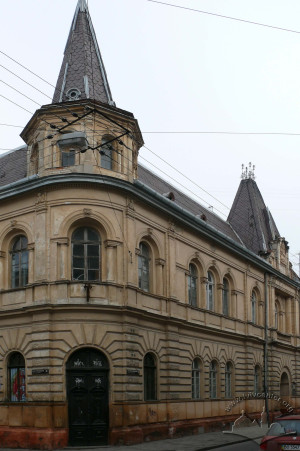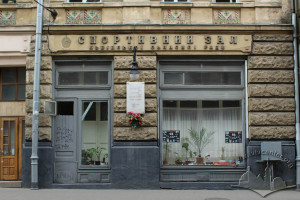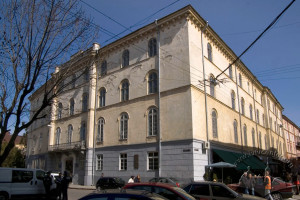Dance Balls of Lviv students ID: 134
A special kind of student activities in the sphere of friendly life was the organization of dance balls and parties. Mostly, students arranged their presentation balls in winter, in January or February. Often, dance balls and parties took place under the patronage of scientists and professors of the University.
Story
For the young people, the period of studying at the university was not the time of intensive work and studies only, but also the time of hectic development of social life. Students organized assemblies, friendly meetings, went to theaters, cinema, and football matches. Occasionally they met in popular Lviv places (for example, in the coffeehouses Roma on ul. Akademicka, 25 and Szkocka on ul. Akademicka,27 (now prosp. Shevchenka). Going to the coffeehouses was associated with considerable expenses, so the Society of Fraternal Help of the Jan Kazimierz University arranged a tea house on ul. Łozińskiego, 7 (now vul. Hertsena). It also organized the solemn Vigil and Easter breakfast for those students who could not afford going home on holidays through lack of appropriate finances. A special kind of student activities in the sphere of friendly life was the organization of dance balls and parties.
Mostly, students arranged their presentation balls in winter, in January or February. Dance parties often took place in the halls of the City Casino and the Literary and Artistic Circle on the lively Akademicka street (now prosp. Shevchenka, 13) or in the hall of the Officer Courses (pol. Ognisko Oficerskie) on ul. Fredra, 1. Both these buildings were located in the immediate city center, not far from the university buildings and dormitories. Stanisław Herbst, a Polytechnic student, recalled that in his student days they also used to go to parties arranged in the building of Count Skarbek (the Zankovetska Theater), in the Sokoł building (now vul. Dudayeva, 8) and on ul. Łozińskiego (now Hertsena). A large dancing hall was also in the 2nd House of Technicians on ul. Abrahamowiczów, 14 (now the hostel of the National University of Lviv Polytechnic on vul. Boy-Zhelenskoho, 14). Sometimes dance balls were also organized in the premises of higher educational institutions (for example, in February 1931, law students arranged a rout in the presentation rooms of the Jan Kazimierz University's rectorate). Premises for the arrangement of parties was also leased by the Academic Reading Room, which offered its services usually for a payment. Sometimes student organizations did not have the funds to pay the bill. This was the case with the Lviv Academic Choir, which, organizing a dance party on March 19 (St. Joseph's Feast), did not receive the expected profit.
Dance balls were also arranged by popular associations of Ukrainian students, such as the "Medical Community" (which hosted the popular "Ball of Physicians" for the first time as early as 1911) or the Student Community. To brighten up the time for students, they invited popular orchestras, which at that time included the Jabcio. In the 1930s, dance parties, which were organized typically on Saturday in the hall of the Society Sokil on ul. Ruska, 20, were popular among young Ukrainians. There were also dance courses there. The young people representing the Russophile trend and united in the association Drug, willingly arranged parties in the hall of the Ruthenian casino on ul. Rutowskiego, 22 (now vul. Teatralna).
It happened that a dance ball organized by student youth was attended by people outside of their circle. The ticket for the latter was twice as expensive as for students. The organization of parties and dance evenings took a lot of time and was associated with the need to resolve numerous formalities (including at least obtaining consent from the Tax Chamber for the sale of alcohol during the party); besides, it was a significant source of profit for many academic societies. The funds collected in this way were intended for the development of individual academic institutions or student housing resources. According to these principles, on 24 November 1927 the Adam Mickiewicz dormitory administration organized the Great Dance Party, whose profits were assigned to renovate the dormitory. In a similar way, funds were collected by the students of the Jan Kazimierz University, who, through the organization of parties, were looking for financial means for building the Female Students' House on ul. Torosiewicza, 36 (now vul. Studentska, 2). It is worth noting that, in addition to dance balls and parties, an important academic initiative, which served to collect money for students' needs, was the annual organization of the Academician Week (which lasted for about 10 days every year), during which young people arranged routs, concerts, lotteries, theatrical and film performances.
Often, dance balls and parties took place under the patronage of scientists and professors of the University. On 14 April 1923 the "All-Polish Youth" organized the Great Spring Rout under the patronage of Stanisław Grabski, Jan Rozwadowski, and Leonard Stahl. The teachers themselves also happened to participate in dance balls organized by students. Probably, a frequent guest, eagerly invited by female students, was mathematician Stefan Banach.
Often it was in the text of invitations that organizers announced what clothes should be worn when attending their dance ball. It could be both a dress for solemn occasions and a suit or a mask. Leon Kaltenberg, a writer and student of the humanities faculty at the Jan Kazimierz University, later recalled Tadeusz Niedźwiedzki, one of the "eternal students", who for many years "wintered" at the University and, therefore, knew all junior researchers and was invited to assistants' dance balls. A legend, popular in the student circles, was a case with Niedźwiedzki who sold his coat to buy white gloves specifically for a dance ball. Kaltenberg then wrote about him: "And what to do with such a softhead, who was going to wear his summer coat for the rest of the winter which was not too mild in that year?". Buying a proper outfit, as well as participating in dance balls, was a privilege of wealthier students; that is why those who happened to go to a lecture just after the late night party, were looked at in an unfriendly manner.
Organizations
Related buildings and spaces
Sources
- Центральний державний архів України у Львові (ЦДІАЛ), 424/1/37:1.
- ЦДІАЛ 424/1/38: 67, 99.
- ЦДІАЛ 424/1/41: 89, 92, 96, 106, 109, 163.
- ЦДІАЛ 424/1/46: 252.
- ЦДІАЛ 754/1/11: 114.
- Державний архів Львівської області (ДАЛО) 26/14/434:26.
- ДАЛО 26/17/64:11.
- ДАЛО 26/17/86: 17.
- Zakład Narodowy im. Ossolińskich we Wrocławiu, sygn. 15336/II/2: Piotr Babczyszyn, Od Gniezny i Seretu po Łynę i Nysę. Wspomnienia, T. II: 1914–1939, 250.
- Zakład Narodowy im. Ossolińskich we Wrocławiu, sygn. 15676/II/1: Stanisław Herbst, Wspomnienia (z lat 1910–1944), T. 1: W promieniu 200 km.
- Emil Szczurowski, Ekspres Akademicki: Lwów. V Tydzień Akademika, Jednodniówka, 1926, s. 1–2.
- Emil Szczurowski, Ta joj: 6. Tydzień akademika (Lwów, Nakł. E. Szczurowski, 1927)
- Lew Kaltenbergh, Ułamki stłuczonego lustra. Dzieciństwo na Kresach. Tamten Lwów (Warszawa: Czytelnik, 1991), 101.
- Jolanta Kamińska-Kwak, Inteligencja województwa lwowskiego w okresie międzywojennym (Rzeszów: Wydawnictwo Uniwersytetu Rzeszowskiego, 2005), 400.
- Marjan Tyrowicz, Wspomnienia o życiu kulturalnym i obyczajowym Lwowa 1918–1939 (Wrocław–Warszawa–Kraków–Gdańsk: Zakład Narodowy im. Ossolińskich, 1991), 49–50.
- Ігор Осташ, Бонді або повернення Богдана Весоловського (Київ: Дуліби, 2013), 58, 61.
Citation
Ewa Bukowska-Marczak. "Dance Balls of Lviv students". Transl. by Andriy Masliukh. Lviv Interactive (Center for Urban History 2018). URL: https://lia.lvivcenter.org/en/themes/baly-studentiv/











